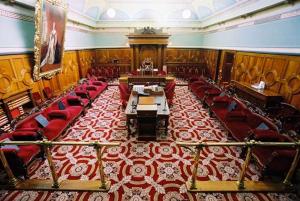Legislative Council Chamber

Legislative Council Chamber
HISTORY
From 1841 to 1856 the Legislative Council met in the Long Room which became the House of Assembly Chamber (1856-1940) and is now the Members' Lounge. The Customs Department, which shared the building until 1905, was then restricted to the far southern wing of the building.
In 1856 the Council moved into the present Chamber, which is one of the most magnificent rooms in the building. In the Westminster tradition, the predominant colour is red. The wood panelling is made of highly polished New South Wales cedar and was constructed by a local firm of tradesmen. The walls above the panelling and the ceiling are hand stencilled and are a spectacular design. The canopy above the President's chair is of cedar.
CURRENT CHAMBER
The Legislative Council Chamber is highly ornate and is dominated by a high ceiling and clerestory. The Members' benches consist of two rows of red couches that face each other across the Chamber. The seating plan of the Members is primarily based on the length of time the Member has been in the Council.
In accordance with Westminster tradition, it is the custom for government representatives, especially the Leader for the Government, to be seated to the right of the President on the first couch. The Chair of Committees (when the Council is in Committee) sits between the Clerk of the Council and the Deputy Clerk.
A large portrait of Queen Victoria hangs on the southern wall opposite one entrance to the Chamber. The portrait was painted by J. Prescott Knight RA and is a copy in oils of Winterhalter's famous painting. The original portrait hangs in Windsor Castle. This copy, purchased in 1855 at a cost of 250 guineas measures 15 feet by 8 feet and its frame is handsomely carved and gilded.
The individual seats on either side of the President on the dais are known as the President's Reserve. Behind these seats to the President's right is the area reserved for the Hansard staff who record the debate. The corresponding area to the President's left is reserved for members of the press.
The public gallery is at the other end of the Chamber from the President's dais and can be accessed by the public via doors to the left of the Chamber. The public is welcome to view the operations of the Legislative Council whenever it is sitting.
THE BLACK ROD
The Black Rod is a symbol of the authority of the Legislative Council as a formal arm of the Parliament. The origins of the position of Usher of the Black Rod go back to the year 1348 when the Order of the Garter was created as part of the English King's bodyguard. As is the situation with the Mace in the House of Assembly, the Usher of the Black Rod was originally able to arrest people using the authority of the staff, or 'Rod'.
In 1361 King Edward III created the position to administer the ceremonies surrounding the new Order of the Garter. When Henry VIII moved his palace from Westminster to Whitehall in about 1530 he 'left the doors of the High Court of Parliament in the care and custody of an usher', so the authority was originally awarded directly by the sovereign.
When the monarch and the Parliament moved further apart constitutionally, the Usher no longer had to perform royal duties so the Black Rod became a symbol for the authority of upper House debate. It is therefore carried in front of the President of the Council as he or she enters and leaves the Chamber.
TASMANIA'S BLACK ROD
Sadly, despite extensive research the origins of the Tasmanian Black Rod remain uncertain. It is made of ebony and richly wrought gold with a lion holding the motto of the Order of the Garter - Honi Soit Qui Mal Y Pense (meaning 'Evil to him who thinks evil'). The base has the same royal coat of arms as the President's Chair and the one that appears above the main entrance to Parliament House.
PRESIDENT'S CHAIR
The President's Chair is one of the symbols of the highest office in the Parliament. The current President's Chair was originally the one used by the Lieutenant-Governor prior to responsible government in 1856. The chair used by the President prior to 1856 is now used as the Speaker's Chair in the House of Assembly.
The chair is made of Tasmanian blackwood and is highly carved, but no reason for the tilt or lean given to the coat of arms at the top can be determined. One view is that it represents the angle at which a royal sword is worn, on one's hip.
The motto Honi Soit Qui Mal Y Pense ('Evil to him who thinks evil') is for the Order of the Garter, and Dieu Et Mon Droit ('God and My Right') is that of the English monarch.
Also of interest is the fact that Her Majesty Queen Elizabeth II used this chair while performing the opening ceremony of Parliament on 22 February 1954. Today the chair is used by the State Governor during the opening ceremony of each new Parliament.
